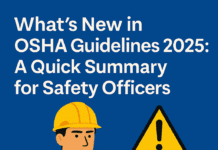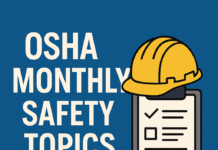
Near Miss Definition OSHA
In workplaces across various industries, safety is paramount. Employers strive to maintain a safe environment for their employees, adhering to regulations set forth by organizations such as the Occupational Safety and Health Administration (OSHA). One crucial aspect of ensuring workplace safety is the identification and reporting of near miss incidents.
What is a Near Miss?
Before delving into OSHA’s definition, it’s essential to understand what constitutes a near miss. A near miss is an unplanned event that has the potential to cause harm, injury, or damage but ultimately does not result in any injury or damage. These incidents often serve as warning signs, indicating potential hazards or flaws in safety protocols that need addressing.
OSHA’s Perspective on Near Miss Incidents
OSHA defines a near miss as an incident where no property was damaged and no personal injury sustained, but where, given a slight shift in time or position, damage and/or injury easily could have occurred. This definition underscores the significance of near misses as indicators of underlying safety issues that require attention.
Legal Implications and Regulations
From a legal standpoint, near miss reporting is crucial for compliance with OSHA regulations. While near misses may not result in immediate harm, failure to address underlying safety concerns can lead to more severe accidents in the future. OSHA mandates that employers maintain a safe workplace and take proactive measures to identify and mitigate hazards, including reporting near miss incidents.
Examples of Near Miss Incidents
Near misses can occur in various workplace settings and situations. Examples include:
- A forklift narrowly avoiding a collision with pedestrian workers in a busy warehouse.
- An employee slipping but managing to catch themselves before falling down a flight of stairs.
- A piece of equipment malfunctioning but causing no harm due to quick intervention by vigilant employees.
These examples highlight the potential dangers present in everyday work environments and the importance of identifying near miss incidents to prevent future accidents.
Benefits of Reporting Near Misses
Reporting near misses offers several benefits to both employers and employees:
- Prevention of Future Accidents: By addressing underlying safety issues identified through near miss reporting, employers can prevent more severe accidents from occurring.
- Improving Safety Protocols: Analyzing near miss incidents allows organizations to identify weaknesses in existing safety protocols and implement improvements to enhance workplace safety.
Steps to Report and Document Near Misses
Encouraging a culture of near miss reporting is essential for effective safety management. Employers can take the following steps to facilitate reporting:
- Promoting Awareness: Educate employees about the importance of near miss reporting and reassure them that reporting will not result in punitive action.
- Establishing Reporting Procedures: Implement clear and accessible procedures for reporting near miss incidents, including designated reporting channels and forms.
- Documenting Incidents: Ensure thorough documentation of near miss incidents, including details such as date, time, location, and potential hazards involved.
Analysis of Near Miss Data
Analyzing data from near miss reports can provide valuable insights into potential hazards and areas for improvement. By identifying trends and patterns in near miss incidents, employers can:
- Identify Root Causes: Determine underlying factors contributing to near miss incidents and take corrective action to address them.
- Implement Proactive Measures: Proactively implement safety measures to prevent similar incidents from occurring in the future.
Training and Education on Near Miss Awareness
Employee awareness and participation are crucial for effective near miss reporting. Employers should provide comprehensive training and education programs to:
- Raise Awareness: Educate employees about the importance of near miss reporting and empower them to recognize and report potential hazards.
- Provide Training: Offer training sessions on identifying and responding to near miss incidents, including proper reporting procedures.
Near Miss Reporting Systems
Implementing robust reporting systems is essential for capturing and addressing near miss incidents effectively. Employers can:
- Utilize Technology: Leverage technology such as incident reporting software to streamline the reporting process and ensure timely response to near miss incidents.
- Encourage Participation: Foster a culture of reporting by encouraging active participation and providing incentives for near miss reporting.
Challenges in Near Miss Reporting
Despite its importance, near miss reporting can face challenges, including:
- Underreporting: Employees may hesitate to report near misses due to fear of repercussions or a lack of understanding of the reporting process.
- Cultural Barriers: Organizational cultures that prioritize productivity over safety may discourage reporting or downplay the significance of near miss incidents.
Integration of Near Miss Reporting with Safety Programs
To maximize the effectiveness of near miss reporting, employers should integrate it into existing safety programs. This involves:
- Incorporating Reporting Into Protocols: Embed near miss reporting into routine safety protocols and procedures to ensure consistency and visibility.
- Continuous Improvement: Continuously assess and refine safety programs based on insights gained from near miss reporting to enhance overall safety performance.
The Role of Leadership in Near Miss Prevention
Leadership plays a critical role in fostering a culture of safety and promoting near miss reporting. Leaders should:
- Lead by Example: Demonstrate a commitment to safety by actively participating in near miss reporting and encouraging open communication.
- Provide Support: Create a supportive environment where employees feel comfortable reporting near misses without fear of reprisal.
Conclusion
Near miss reporting is a vital component of workplace safety, offering valuable insights into potential hazards and opportunities for improvement. By encouraging a culture of reporting, implementing robust reporting systems, and integrating near miss reporting into existing safety programs, organizations can enhance workplace safety and prevent accidents.
Top 10 OSHA Violations in 2024
OSHA Standards for Construction and General Industry
OSHA: Hazard Communication Standard 1926.59
FAQs About Near Miss Reporting
- What is the difference between a near miss and an accident?
- Near misses are incidents where harm or damage could have occurred but was narrowly avoided, whereas accidents result in actual harm or damage.
- Why is near miss reporting important?
- Near miss reporting helps identify potential hazards and weaknesses in safety protocols, allowing organizations to take proactive measures to prevent accidents.
- Are near miss incidents legally required to be reported?
- While near misses may not have legal reporting requirements in all jurisdictions, reporting them is essential for maintaining workplace safety and compliance with regulations such as OSHA standards.
- How can organizations encourage employees to report near misses?
- Employers can encourage near miss reporting by fostering a culture of safety, providing training on reporting procedures, and ensuring that employees feel supported and valued for their contributions to safety.
- What should employers do with near miss reports?
- Employers should thoroughly investigate near miss reports, identify root causes, and take corrective action to prevent similar incidents in the future.
























